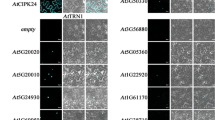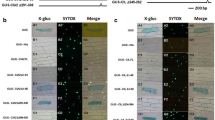Abstract
We characterized the Arabidopsis orthologue of the human nuclear import receptor transportin1 (TRN1). Like the human receptor, Arabidopsis TRN1 recognizes nuclear import signals on proteins that are different from the classical basic nuclear localization signals. The M9 domain of human heterogeneous nuclear ribonucleoprotein A1 (hnRNP A1) is the prototype of such signals. We show that AtTRN1 binds to similar domains in hnRNP-like proteins from plants. AtTRN1 also interacts with human hnRNP A1 and with yeast Nab2p, two classical import cargo proteins of transportin in these organisms. Like all nuclear transport receptors of the importin-β family, AtTRN1 binds to the regulatory GTPase Ran from Arabidopsis. We demonstrated that the amino terminus of AtTRN1 is necessary for this interaction. Recombinant AtTRN1 conferred nuclear import of fluorescently labelled BSA-M9 peptide conjugates in permeabilized HeLa cells, functionally replacing human TRN1 in these in vitro nuclear import assays. We identified three plant substrate proteins that interact with AtTRN1 and contain M9-like domains: a novel Arabidopsis hnRNP that shows high similarity to human hnRNP A1 and two small RNA-binding proteins from Arabidopsis, AtGRP7 and AtGRP8. Nuclear import activity of the M9-like domains of these plant proteins was demonstrated in vivo by their ability to confer partial nuclear re-localisation of a GFP fusion protein containing a nuclear export signal. In addition, fluorescently labelled AtGRP7 was specifically imported into nuclei of permeabilized HeLa cells by Arabidopsis AtTRN1 and human TRN1. These results suggest that the transportin-mediated nuclear import pathway is highly conserved between man, yeast and plants.
Similar content being viewed by others
References
Aitchison, J.D., Blobel, G. and Rout, M.P. 1996. Kap104p: a karyopherin involved in the nuclear transport of messenger RNA binding proteins. Science 274: 624–627.
Arabidopsis Genome Initiative 2000. Analysis of the genome sequence of the flowering plant Arabidopsis thaliana. Nature 408: 796–815.
Bachi, A., Braun, I.C., Rodrigues, J.P., Pante, N., Ribbeck, K., von Kobbe, C., Kutay, U., Wilm, M., Görlich, D., Carmo-Fonseca, M. and Izaurralde, E. 2000. The C-terminal domain of TAP interacts with the nuclear pore complex and promotes export of specific CTE-bearing RNA substrates. RNA 6: 136–158.
Bogerd, H.P., Benson, R.E., Truant, R., Herold, A., Phingbodhipakkiya, M. and Cullen, B.R. 1999. Definition of a consensus transportin-specific nucleocytoplasmic transport signal. J. Biol. Chem. 274: 9771–9777.
Bollman, K.M., Aukerman, M.J., Park, M.Y., Hunter, C., Berardini, T.Z., and Poethig R.S. 2003. HASTY, the Arabidopsis ortholog of exportin 5/MSN5, regulates phase change and morphogenesis. Development 130: 1493–1504.
Bonfaci, N., Moroianu, J., Radu, A. and Blobel, G. 1997. Karyopherin β2 mediates nuclear import of a mRNA binding protein. Proc. Natl. Acad. Sci. USA 94: 5055–5060.
Carpenter, C.D., Kreps, J.A. and Simon, A.E. 1994. Genes encoding glycine-rich Arabidopsis thaliana proteins with RNA-binding motifs are influenced by cold treatment and an endogenous circadian rhythm. Plant Physiol. 104: 1015–1025.
Chook, Y.M. and Blobel, G. 1999. Structure of the nuclear transport complex karyopherin-β2-Ran•GppNHp. Nature 399: 230–237.
Fridell, R.A., Truant, R., Benson, R.E. and Cullen, B.R. 1997. Nuclear import of hnRNP A1 is mediated by a novel cellular cofactor related to karyopherin-β. J. Cell Sci. 110: 1325–1331.
Görlich, D. and Kutay, U. 1999. Transport between the nucleus and the cytoplasm. Annu. Rev. Cell Dev. Biol. 15: 607–660.
Görlich, D., Pante, N., Kutay, U., Aebi, U. and Bischoff, F.R. 1996. Identification of different roles for RanGDP and RanGTP in nuclear protein import. EMBO J. 15: 5584–5594.
Haasen, D., and Merkle, T. 2002. Characterisation of an Arabidopsis thaliana homologue of the nuclear export receptor CAS by its interaction with Importin alpha. Plant Biol. 4: 432–439.
Haasen, D., Köhler, C., Neuhaus, G. and Merkle, T. 1999. Nuclear export of proteins in plants: AtXPO1 is the export receptor for leucine-rich nuclear export signals in Arabidopsis thaliana. Plant J. 20: 695–705.
Haizel, T., Merkle, T., Pay, A., Fejes, E. and Nagy, F. 1997. Characterization of proteins that interact with the GTP-bound form of the regulatory GTPase Ran in Arabidopsis. Plant J. 11: 93–103.
Heintzen, C., Nater, M., Apel, K. and Staiger, D. 1997. AtGRP7, a nuclear RNA-binding protein as a component of a circadianregulated negative feedback loop in Arabidopsis thaliana. Proc. Natl. Acad. Sci. USA 94: 8515–8520.
Hicks, G.R., Smith, H.M., Lobreaux. S. and Raikhel, N.V. 1996. Nuclear import in permeabilized protoplasts from higher plants has unique features. Plant Cell 8: 1337–1352.
Izaurralde, E., Kutay, U., von Kobbe, C., Mattaj, I.W. and Görlich, D. 1997. The asymmetric distribution of the constituents of the Ran system is essential for transport into and out of the nucleus. EMBO J. 16: 6535–6547.
Jäkel, S. and Görlich, D. 1998. Importin β, transportin, RanBP5 and RanBP7 mediate nuclear import of ribosomal proteins in mammalian cells. EMBO J. 17: 4491–4502.
Jiang, C.J., Imamoto, N., Matsuki, R., Yoneda, Y. and Yamamoto, N. 1998. In vitro characterization of rice importin beta 1: molecular interaction with nuclear transport factors and mediation of nuclear protein import. FEBS Lett. 437: 127–130.
Krecic, A.M. and Swanson, M.S. 1999. hnRNP complexes: composition, structure, and function. Curr. Opin. Cell Biol. 11: 363–371.
Lorkovic, Z.J., Wieczorek Kirk, D.A., Lambermon, M.H.L. and Filipowicz, W. 2000. Pre-mRNA splicing in higher plants. Trends Plant Sci. 5: 160–167.
Merkle, T. 2001. Nuclear import and export of proteins in plants: a tool for the regulation of signalling. Planta 213: 499–517.
Merkle, T., Leclerc, D., Marshallsay, C. and Nagy, N. 1996. A plant in vitro system for the nuclear import of proteins. Plant J. 10: 1177–1186.
Mili, S., Shu, H.J., Zhao, Y. and Pinol-Roma, S. 2001. Distinct RNP complexes of shuttling hnRNP proteins with pre-mRNA and mRNA: candidate intermediates in formation and export of mRNA. Mol. Cell. Biol. 21: 7307–7319.
Nakielny, S. and Dreyfuss, G. 1996. The hnRNP C proteins contain a nuclear retention sequence that can override nuclear export signals. J. Cell Biol. 134: 1365–1373.
Nakielny, S. and Dreyfuss, G. 1997. Nuclear export of proteins and RNAs. Curr. Opin. Cell Biol. 9: 420–429.
Norvell, A., Kelley, R.L., Wehr, K. and Schüpbach, T. 1999. Specific isoforms of Squid, a Drosophila hnRNP, perform distinct roles in Gurken localization during oogenesis. Genes Dev. 13: 864–876.
Pinol-Roma, S. and Dreyfuss, G. 1992. Shuttling of pre-mRNA binding proteins between nucleus and cytoplasm. Nature 355: 730–732.
Pollard, V.W., Michael, W.M., Nakielny, S., Siomi, M.C., Wang, F. and Dreyfuss, G. 1996. A novel receptor-mediated nuclear protein import pathway. Cell 86: 985–994.
Ribbeck, K., Kutay, U., Paraskeva, E. and Görlich, D. 1999. The translocation of transportin-cargo complexes through nuclear pores is independent of both Ran and energy. Curr. Biol. 9: 47–50.
Shamsher, M.K., Ploski, J. and Radu, A. 2002. Karyopherin β2B participates in mRNA export from the nucleus. Proc. Natl. Acad. Sci. USA 99: 14195–14199.
Siomi, H. and Dreyfuss, G. 1995. A nuclear localization domain in the hnRNP A1 protein. J. Cell Biol.129: 551–559.
Siomi, M.C., Eder, P.S., Kataoka, N., Wan, L., Liu, Q. and Dreyfuss, G. 1997. Transportin-mediated nuclear import of heterogeneous nuclear RNP proteins. J. Cell Biol. 138: 1181–1192.
Siomi, M.C., Fromont, M., Rain, J.-C., Wan, L., Wang, F., Legrain, P. and Dreyfuss, G. 1998. Functional conservation of the transportin nuclear import pathway in divergent organisms.Mol. Cell. Biol. 18: 4141–4148.
Staiger, D. 2002. Circadian rhythms in Arabidopsis: time for nuclear proteins. Planta 214: 334–344.
Staiger, D. and Apel, K. 1999. Circadian clock-regulated expression of an RNA-binding protein in Arabidopsis: characterisation of a minimal promoter element. Mol. Gen. Genet. 261: 811–819.
Staiger, D., Zecca, L., Wieczorek Kirk, D.A., Apel, K. and Eckstein, L. 2003. The circadian clock regulated RNA-binding protein AtGRP7 autoregulates its expression by influencing alternative splicing of its own pre-mRNA. Plant J. 33: 361–371.
Thomson, J.D., Higgins, D.G. and Gibson, T.J. 1994. Clustal W: improving the sensitivity of progressive multiple sequence alignment through sequence weighting, position-specific gap penalties and weight matrix choice. Nucl. Acid Res. 22: 4673–4680.
Truant, R., Fridell, R.A., Benson, R.E., Bogerd, H. and Cullen, B.R.1998. Identification and functional characterization of a novel nuclear localization signal present in the yeast Nab2 poly(A)+ RNA binding protein. Mol. Cell. Biol. 18: 1449–1458.
Truant, R., Kang, Y. and Cullen, B.R. 1999. The human Tap nuclear RNA export factor contains a novel Transportin-dependent nuclear localization signal that lacks export signal function. J. Biol. Chem. 274: 32167–32171.
van Nocker, S. and Vierstra, R.D. 1993. Two cDNAs from Arabidopsis thaliana encode putative RNA binding proteins containing glycine-rich domains. Plant Mol. Biol. 21: 695–699.
Weighardt, F., Biamonti, G. and Riva, S. 1995. Nucleo-cytoplasmic distribution of human hnRNP proteins: a search for the targeting domains in hnRNP A1. J. Cell Sci. 108: 545–555.
Author information
Authors and Affiliations
Corresponding author
Additional information
These authors contributed equally to this work
These authors contributed equally to this work
Rights and permissions
About this article
Cite this article
Ziemienowicz, A., Haasen, D., Staiger, D. et al. Arabidopsis transportin1 is the nuclear import receptor for the circadian clock-regulated RNA-binding protein AtGRP7. Plant Mol Biol 53, 201–212 (2003). https://doi.org/10.1023/B:PLAN.0000009288.46713.1f
Issue Date:
DOI: https://doi.org/10.1023/B:PLAN.0000009288.46713.1f




